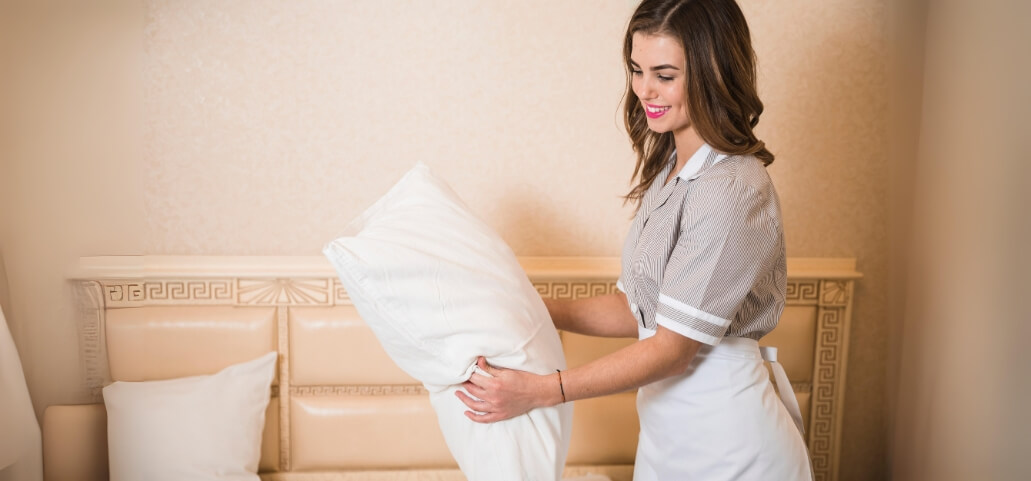Knowing how to wash a pillow is essential for a healthy sleep environment. Over time, pillows collect dirt, sweat, and allergens, making regular washing necessary. This guide will show you how to wash a pillow correctly, keeping it fresh, fluffy, and hygienic. Whether you have a feather, memory foam, or synthetic pillow, our step-by-step instructions will help you maintain your bedding and extend its lifespan. Say goodbye to dirty pillows and hello to cleaner, more comfortable sleep! Let’s dive into how to wash a pillow.
Why Pillow Hygiene Matters
Pillows provide a warm and comfortable place for your head to rest, making them the perfect environment for dust mites, bacteria, and other allergens. Over time, these microscopic organisms can build up in your pillow, leading to potential health issues such as allergies and respiratory problems. Regularly washing your pillows can help eliminate these irritants and keep your bedding fresh and clean. Additionally, dirty pillows can lose their shape and support over time, resulting in an uncomfortable sleep experience. By following proper cleaning techniques, you can preserve the quality of your pillows and ensure a good night’s rest.
Step-by-Step Guide to How to Wash a Pillow at Home

1: Check the Care Label
Before you toss that pillow into the wash, take a peek at the care label for instructions. Different materials need different care, so it’s super important to follow the manufacturer’s guidelines. Some pillows might be divas that only accept dry cleaning, while others are cool with a spin in the washing machine. Ignoring these instructions can damage the pillow’s filling or outer fabric.
Step 2: Pre-Treat Stains
To effectively remove stains from your pillow, pre-treat them with a stain remover before washing. Spread the stain remover liberally and wait 10 to 15 minutes for the spots to dissolve. For tougher stains, you may need to repeat this step or gently scrub with a soft brush. This pre-treatment helps ensure the stains are fully eliminated during washing.
Step 3: Washing Machine Settings
For machine-washable pillows, select a gentle cycle and use a mild detergent. Harsh detergents can degrade the pillow’s filling and cause it to lose its shape. Wash two pillows at a time to balance the load, and consider adding a couple of towels for extra cushioning. This helps prevent the pillows from getting bunched up or damaged during the spin cycle.
Step 4: Rinse Thoroughly
To get rid of any remaining detergent, repeat the rinsing cycle after the wash cycle. Residual soap can irritate your skin and affect the pillow’s comfort. You should wait until the water flows clean before stopping the rinse. This step is crucial for people with sensitive skin or allergies, as leftover detergent can cause discomfort.
Step 5: Drying Process
Dry your pillows in a low heat setting to prevent any damage to the filling. To avoid lumps and fluff, try stuffing the pillows with clean tennis balls or dryer balls. The balls beat against the pillows, breaking up any lumps and keeping them soft and fluffy. Ensure the pillows are completely dry to avoid mold and mildew. You may need to run several drying cycles and manually fluff the pillows between cycles to achieve this. If possible, dry them outside on a sunny day for a fresh, airy scent.
Identifying the Right Washing Method for Different Pillow Types
Not all pillows are created equal, and therefore they may require different washing methods. Here are the most common types of pillows and how to wash them:
Feather or Down Pillows:
Feather and down pillows provide a soft and luxurious sleep experience. You should be extra careful while washing items with these natural fillings because of their fragility. To clean a feather or down pillow, follow these steps:
- Check the label for specific instructions: Some feather/down pillows may have specific cleaning instructions such as dry cleaning only, so it’s essential to check the label before proceeding.
- Pre-treat stains: Apply a small amount of mild detergent or stain remover directly to any spots on the pillow.
- Use a gentle cycle: Place the pillow in the washing machine and select a gentle cycle with warm water.
- Rinse thoroughly: Ensure the pillow is rinsed multiple times to eliminate all soap residue.
- Dry completely: If you want to fluff the feathers on your pillow, throw it in the dryer with some clean tennis balls or dryer balls. Use low heat and check periodically until the pillow is fully dry.
Memory Foam Pillows:
The pressure-relieving qualities of memory foam pillows are well-known, but cleaning them can be a real pain. Here’s how to wash a memory foam pillow correctly:
- Spot clean: For visible stains, apply a small amount of mild detergent or spot cleaner and gently blot the area.
- Fill a bathtub with warm water: Fill your bathtub with warm water sufficient to completely submerge the pillow.
- Add mild detergent: Mix a small amount of mild detergent thoroughly into the water.
- Submerge the pillow: Place the pillow in the tub and gently press down to ensure it is fully submerged.
- Rinse thoroughly: Empty the water of its soapy residue and replace it with fresh water. Rinse the pillow multiple times until all soap residue is removed.
- Remove Excess Water: Gently press the pillow to expel any remaining water, taking care not to twist or wring it.
- Air Dry: Lay the pillow flat on a towel and allow it to air dry thoroughly before using it again.
Synthetic Pillows:
Synthetic pillows, such as polyester or microfiber, are usually machine-washable and easy to clean. Here’s how to wash a synthetic pillow:
- Check the label: Most synthetic pillows are machine-washable, but always refer to the label for specific care instructions.
- Use a gentle cycle: Throw the pillow in the washer and wash it on a delicate cycle using warm water.
- Add mild detergent: Just a little gentle detergent will do the trick; fabric softener and bleach are completely unnecessary.
- Rinse thoroughly: For a completely soap-free pillow, give it a good rinsing.
- Dry thoroughly: Keep checking on the pillow from time to time to make sure it’s dry after putting it in the dryer on low heat.
Tips for Maintaining Pillow Cleanliness Between Washes

In order to keep your pillows clean and extend their life, it is vital to wash them regularly. On the other hand, you may maintain their cleanliness and freshness in between washes by doing the following:
- Use a pillow protector: A pillow protector shields your pillow from sweat, dirt, and oils, making it much easier to remove and wash than the entire pillow.
- Air out your pillows: Every few weeks, place your pillows outside on a sunny day to air them out. This helps eliminate any odors or mustiness that may have accumulated.
- Fluff daily: Every day, give your pillows a little fluffing to keep the stuffing from clumping and keep them in shape.
- Replace when necessary: Pillows, no matter how well you take care of them, will wear out and become uncomfortable after a while. Replace them every 1-2 years or when they begin to show signs of wear and tear.
The Benefits of Using Pillow Protectors
Using pillow protectors is an excellent way to maintain the cleanliness of your pillows and extend their lifespan. Pillow protectors have several advantages, including the following:
- Protection from allergens: Pillow protectors can help prevent dust, dirt, and other allergens from settling into your pillow, making it easier for people with allergies to sleep comfortably.
- Easier to clean: Instead of having to wash the entire pillow frequently, you only need to remove and wash the protector regularly.
- Added comfort: Some pillow protectors come with additional features such as cooling or waterproof properties, which can improve your sleeping experience.
- Cost-effective: You may save money by extending the life of your pillows and preventing stains and grime from becoming permanent marks.
- Better for the environment: Regularly washing your pillow protector is more eco-friendly than constantly replacing pillows.
How to Wash a Travel Pillow
Travel pillows are a must-have for any traveler, whether you’re taking a long flight or going on a road trip. But over time, your travel pillow can get dirty and lose its fluffiness, making it less comfortable to use. That’s why it’s important to know how to properly wash your travel pillow.
Step 1: Check the Care Instructions
Travel pillows are made from various materials, making it important to check the care label for specific washing instructions. While some travel pillows are machine-washable, others may need spot cleaning.
Step 2: Spot Clean Memory Foam Travel Pillows
To clean memory foam travel pillows, use a mild detergent and water for spot cleaning. Make sure the pillow is completely dry before use to avoid mold and mildew.
Step 3: Machine Wash Fabric Travel Pillows
Fabric travel pillows are typically machine washable. Dry on a low heat setting after using a delicate cycle with a light detergent for the best results. Adding dryer balls can help preserve the pillow’s shape.
Conclusion
A clean pillow is essential for a good night’s sleep and overall hygiene. By following the correct washing methods for different types of pillows, you can ensure they remain clean and comfortable for years to come. Remember to regularly wash your pillows, use pillow protectors, and replace them when necessary to maintain their cleanliness and support. With these tips, you can enjoy a fresh and cozy sleeping experience every night.
Frequently Asked Questions
Q1: How to wash a pillow without a washing machine?
Answer: You may still clean your pillow by hand if it cannot be machine washed. Follow the steps for hand washing, using a bathtub or large sink instead of a washing machine.
Q2: Can I wash memory foam pillows in the washing machine?
Answer: It is not a good idea to machine wash a memory foam pillow since it can ruin the foam. Instead, spot-clean them with mild detergent and water.
Q3: What is the best way to dry pillows?
Answer: Pillows are best dried by letting them air dry on a level surface. The cushion may be fluffed with the aid of dryer balls and a low heat setting if you must use a dryer.
Q4: How do pillow protectors help with pillow maintenance?
Answer: Pillow protectors act as a barrier, preventing sweat, oils, and dirt from seeping into the pillow. This makes it easier to remove and wash the protector instead of having to constantly wash the entire pillow. So, to keep your pillows clean and prolong their life, use a protector.
Q5: Can I use regular detergents to wash pillows?
Answer: It is recommended to use a mild detergent when washing pillows, as harsh detergents and fabric softeners can damage the pillow’s fillings. Avoid using bleach or strong chemicals on pillows as well. Consequently, you should only use mild detergents made for fragile materials.
Disclaimer: Always check the care instructions and labels on your pillows before washing to ensure you are using the correct method. If in doubt, consult a professional cleaner or contact the manufacturer for advice. It is also important to note that some pillows may not be washable, so it’s best to replace them if they cannot be properly cleaned.
Personal Experience: I’ve always prioritized pillow hygiene, especially since I suffer from allergies. I used to have terrible sleep quality until I started frequently washing my pillows. I use pillow protectors to reduce the frequency of washes, and I find that my pillows last much longer as a result. Trust me; once you start maintaining your pillows properly, you’ll notice a world of difference in your sleep and overall health.
Why Trust Our Content?
Professionals conduct extensive research and write all of our articles. If you want to know what’s best for your sleep health, we want you to know that the information we give you is accurate and current. With years of experience, we guide our readers in maintaining a clean, comfortable sleeping environment. Trust us for reliable information on pillows, bedding, and sleep hygiene. If you want to know how to make sure your pillows last and how to have a good night’s sleep, follow us!

